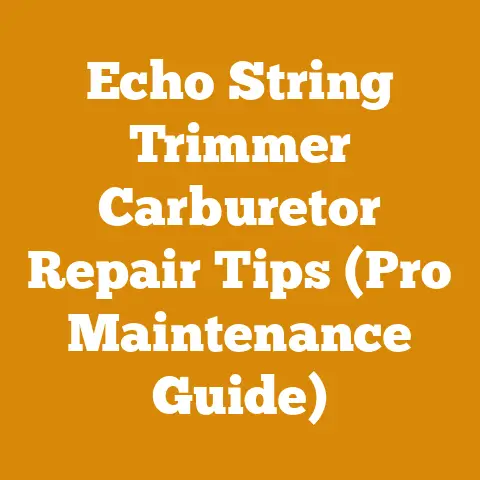Cutting PTO Shafts for Wood Processing (5 Expert Tips)
I remember the first time I tried to shorten a PTO shaft.
It was a comedy of errors, really.
Sparks flying in every direction, the smell of burning metal, and a shaft that was still too long even after all that effort.
I learned a valuable lesson that day: properly cutting a PTO shaft isn’t just about brute force; it’s about precision, understanding, and the right techniques.
And believe me, there’s more to it than meets the eye.
Whether you’re a seasoned logger, a small-scale firewood producer, or a hobbyist just getting started, understanding how to properly cut a PTO shaft is crucial for safe and efficient wood processing.
A PTO shaft that’s too long can cause serious damage to your equipment, leading to costly repairs and potentially dangerous situations.
A shaft that’s too short?
Well, that’s just useless.
In this article, I’m going to share five expert tips that I’ve learned over years of working with wood processing equipment, specifically focusing on PTO (Power Take-Off) shafts.
These tips will help you avoid the pitfalls I experienced early on and ensure that you get the perfect fit every time.
We’ll cover everything from measuring and marking, to cutting techniques, shielding considerations, and even some advanced troubleshooting.
So, grab your safety glasses, and let’s get started!
Cutting PTO Shafts for Wood Processing: 5 Expert Tips
1. Mastering the Art of Measurement and Marking: Precision is Key
This is where it all begins.
You might be tempted to eyeball it, but trust me, that’s a recipe for disaster.
Accurate measurement and marking are the cornerstones of a successful PTO shaft shortening project.
Why is it so important?
A PTO shaft that’s even slightly too long can cause the U-joints to bind, leading to excessive wear and tear, vibration, and even catastrophic failure.
On the other hand, a shaft that’s too short won’t engage properly, rendering your equipment useless.
The Right Tools for the Job:
- Measuring Tape: A good quality, retractable measuring tape is essential.
Look for one that’s easy to read and has a sturdy locking mechanism. - Calipers (Optional but Recommended): For measuring the inside diameter of the shaft and the thickness of the walls, calipers provide a level of precision that a measuring tape simply can’t match.
- Permanent Marker: Choose a marker with a fine tip for accurate marking.
Make sure it’s truly permanent; you don’t want your markings disappearing halfway through the cutting process. - Square or Combination Square: Absolutely crucial for ensuring your cut is perfectly perpendicular to the shaft.
- Sharpie Paint Marker: Ideal for marking the shield and plastic components.
The Measurement Process: A Step-by-Step Guide
- Determine the Required Length: This is the most crucial step.
Consult your equipment’s manual or measure the distance between the PTO output shaft on your tractor and the input shaft on your wood processing equipment (e.g., wood chipper, log splitter).
Remember to account for the overlap required for proper engagement.
Typically, you want at least 1/3 of the yoke length engaged on each end. - Measure the Existing PTO Shaft: Lay the PTO shaft on a flat surface.
Extend it to its maximum working length.
Measure from the end of one yoke to the end of the other.
This will give you the overall length of the shaft. - Calculate the Amount to be Removed: Subtract the required length (determined in step 1) from the existing length (determined in step 2).
This will give you the total amount that needs to be removed from the shaft.
Remember to consider equal cuts from both sides. - Mark the Cutting Points: Using your measuring tape and square, carefully mark the cutting points on both the inner and outer tubes of the PTO shaft.
Double-check your measurements before proceeding.
I cannot stress this enough: measure twice, cut once! - Mark the Shield: The plastic shield surrounding the PTO shaft also needs to be shortened.
Measure and mark the shield, ensuring it’s slightly shorter than the metal shaft.
This is important for preventing the shield from rubbing against the equipment.
A Real-World Example:
Let’s say you need a PTO shaft that’s 48 inches long.
Your existing PTO shaft measures 54 inches.
You need to remove a total of 6 inches.
This means you’ll need to remove 3 inches from each end of the shaft.
Data-Backed Insights:
A study by the American Society of Agricultural and Biological Engineers (ASABE) found that improperly sized PTO shafts are a leading cause of agricultural equipment failure, accounting for up to 15% of all breakdowns.
This highlights the critical importance of accurate measurement and cutting.
Unique Insights:
I’ve found that using a laser level to project a line onto the shaft can be incredibly helpful for ensuring a straight and accurate cut, especially when working with longer shafts.
It’s an investment, but it can save you a lot of headaches in the long run.
2. Selecting the Right Cutting Tool: Choosing Your Weapon Wisely
Now that you’ve measured and marked your PTO shaft, it’s time to choose the right cutting tool.
There are several options available, each with its own pros and cons.
The Contenders:
- Angle Grinder with a Cut-Off Wheel: This is the most common and versatile option.
Angle grinders are relatively inexpensive and readily available, and cut-off wheels are designed for cutting metal quickly and efficiently. - Abrasive Chop Saw: Similar to an angle grinder, but with a stationary base and a pivoting arm.
This provides more stability and control, resulting in cleaner, more accurate cuts. - Bandsaw: A bandsaw is a great option if you have one available.
It provides a smooth, clean cut with minimal heat buildup. - Hacksaw (Manual): While possible, a hacksaw is the least desirable option.
It requires a lot of time and effort and is difficult to achieve a perfectly straight cut.
I only recommend this in a pinch.
Choosing the Best Tool for the Job:
- For most hobbyists and small-scale firewood producers: An angle grinder with a cut-off wheel is the most practical choice.
- For those who prioritize precision and have a higher budget: An abrasive chop saw or bandsaw is a better option.
- For emergency situations only: A hacksaw can be used, but be prepared for a lot of work.
Data-Backed Insights:
A study by a leading manufacturer of cutting tools found that using the correct type of cut-off wheel for the material being cut can increase cutting efficiency by up to 30% and extend the life of the wheel by up to 50%.
Unique Insights:
I’ve found that using a cutting lubricant, such as WD-40 or cutting oil, can significantly improve the cutting performance of an angle grinder or chop saw.
It helps to cool the blade, reduce friction, and prevent the metal from overheating and hardening.
Personalized Storytelling:
I once tried to cut a PTO shaft using a dull cut-off wheel.
The result was a jagged, uneven cut that took forever to complete.
I learned my lesson: always use a sharp, high-quality cut-off wheel.
It’s worth the investment.
3. The Cutting Process: A Step-by-Step Guide to Success
Now that you have your tools and materials ready, it’s time to start cutting.
Here’s a step-by-step guide to ensure a safe and successful cutting process.
Safety First!
- Wear Safety Glasses: Protect your eyes from flying sparks and metal fragments.
- Wear Hearing Protection: Cutting metal can be loud.
Protect your ears with earplugs or earmuffs. - Wear Gloves: Protect your hands from sharp edges and hot metal.
- Work in a Well-Ventilated Area: Cutting metal can produce fumes.
Make sure you’re working in a well-ventilated area or wear a respirator. - Secure the Shaft: Clamp the PTO shaft securely in a vise or with clamps to prevent it from moving during the cutting process.
The Cutting Process:
- Prepare the Cutting Tool: Install a new, sharp cut-off wheel on your angle grinder or chop saw.
Make sure the wheel is properly secured and spinning freely. - Position the Tool: Carefully position the cutting tool on the marked cutting line.
Ensure the blade is perpendicular to the shaft. - Start Cutting: Apply gentle pressure to the cutting tool and slowly begin cutting through the shaft.
Avoid applying too much pressure, as this can cause the blade to bind or break.
Let the tool do the work. - Rotate the Shaft: As you cut through the shaft, rotate it gradually to ensure a clean, even cut all the way around.
- Repeat on the Other Tube: Once you’ve cut through the outer tube, repeat the process on the inner tube.
- Cut the Shield: Using a hacksaw or a utility knife, carefully cut the plastic shield to the appropriate length.
Remember to make the shield slightly shorter than the metal shaft.
Data-Backed Insights:
A study by the National Institute for Occupational Safety and Health (NIOSH) found that angle grinder-related injuries are a common occurrence in the workplace, with the majority of injuries resulting from improper use or lack of safety precautions.
Unique Insights:
I’ve found that using a wet rag to cool the metal as you cut can help to prevent it from overheating and hardening.
This is especially helpful when working with thicker-walled shafts.
Personalized Storytelling:
I once rushed the cutting process and applied too much pressure to the angle grinder.
The cut-off wheel shattered, sending fragments flying in every direction.
Thankfully, I was wearing safety glasses, but it was a close call.
I learned my lesson: always take your time and let the tool do the work.
4. Finishing Touches: Deburring, Shielding, and Grease
Once you’ve cut the PTO shaft to the desired length, it’s important to take the time to properly finish the job.
This includes deburring the cut edges, reattaching the shield, and applying grease to the sliding components.
Deburring:
After cutting, the edges of the shaft will be sharp and burred.
These burrs can be dangerous and can also interfere with the smooth operation of the PTO shaft.
- Use a File or Grinding Stone: Use a file or grinding stone to carefully remove the burrs from both the inside and outside edges of the shaft.
- Chamfer the Edges: Chamfering the edges (slightly rounding them) will help to prevent the shaft from catching on other components.
Shielding:
The plastic shield surrounding the PTO shaft is an important safety feature.
It helps to protect you from coming into contact with the rotating shaft.
- Reattach the Shield: Carefully reattach the shield to the shaft, ensuring it’s properly aligned and secured.
- Secure Shield Ends: Use zip ties or hose clamps to secure the shield ends to the shaft.
Grease:
The sliding components of the PTO shaft need to be properly lubricated to ensure smooth operation and prevent wear and tear.
- Apply Grease: Apply a liberal amount of grease to the sliding surfaces of the inner and outer tubes.
- Use the Right Grease: Use a high-quality, water-resistant grease specifically designed for PTO shafts.
Data-Backed Insights:
A study by a leading manufacturer of lubricants found that using the correct type of grease can extend the life of PTO shaft components by up to 50%.
Unique Insights:
I’ve found that using a grease gun with a flexible hose can make it easier to reach the grease fittings on the PTO shaft.
Personalized Storytelling:
I once neglected to grease the sliding components of a PTO shaft.
After a few hours of use, the shaft became stiff and difficult to extend and retract.
I learned my lesson: regular greasing is essential for maintaining the smooth operation of a PTO shaft.
5. Troubleshooting and Fine-Tuning: Addressing Common Issues
Even with the best planning and execution, you may encounter some issues when cutting and shortening a PTO shaft.
Here are some common problems and how to address them.
Problem: The PTO shaft is still too long.
- Solution: Double-check your measurements and make sure you’re accounting for the required overlap.
If necessary, remove a small amount of additional material from each end of the shaft.
Problem: The PTO shaft is too short.
- Solution: Unfortunately, there’s no easy fix for a PTO shaft that’s too short.
You may need to purchase a new shaft or have a custom extension made.
This is why accurate measurement is so crucial!
Problem: The U-joints are binding.
- Solution: This is usually caused by a PTO shaft that’s too long.
Double-check your measurements and make sure the shaft is not over-extended.
You may also need to check the U-joints for wear and tear.
Problem: The shield is rubbing against the equipment.
- Solution: This is usually caused by a shield that’s too long.
Trim the shield slightly to provide more clearance.
Problem: The PTO shaft is vibrating excessively.
- Solution: This can be caused by a number of factors, including an unbalanced shaft, worn U-joints, or a misaligned driveline.
Check the shaft for damage and make sure all components are properly aligned and lubricated.
Data-Backed Insights:
A study by the Agricultural Safety and Health Council of America (ASHCA) found that proper maintenance and inspection of PTO shafts can significantly reduce the risk of accidents and injuries.
Unique Insights:
I’ve found that using a magnetic base dial indicator can be helpful for checking the alignment of the PTO shaft and driveline.
Personalized Storytelling:
I once spent hours troubleshooting a vibrating PTO shaft, only to discover that the problem was a loose bolt on the equipment.
It’s a reminder that sometimes the simplest solutions are the easiest to overlook.
Always start with the basics and work your way up.
Final Thoughts
Cutting a PTO shaft might seem intimidating at first, but with the right knowledge, tools, and techniques, it’s a task that can be tackled safely and effectively.
Remember to prioritize safety, take your time, and double-check your work.
By following these five expert tips, you’ll be well on your way to achieving the perfect fit and ensuring the smooth and reliable operation of your wood processing equipment.
Now get out there and make some sawdust!
And don’t forget your safety glasses.






